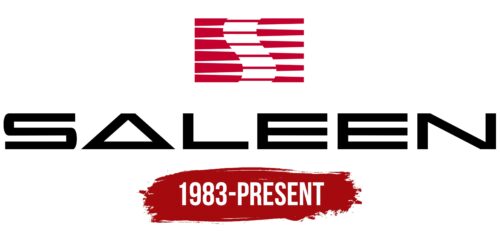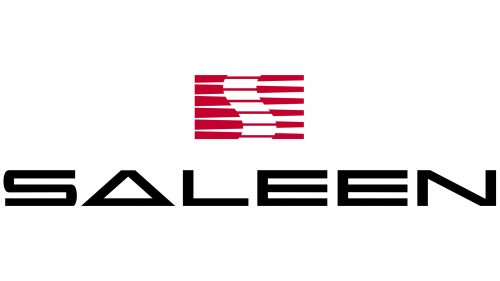The Saleen logo embodies the spirit of competition and the relentless pursuit of leadership in the world of automobiles. Its dynamic lines, combined with an aggressive design, emphasize the speed and agility of sports cars, reflecting the company’s racing heritage.
Saleen: Brand overview
The well-known race car driver and motorsports enthusiast Steve Saleen established Saleen Autosport in Southern California in 1983, marking the beginning of the company’s history. Steve Saleen used his Formula Atlantic racing experience and expertise to produce cars.
The Ford Mustang conversion was the company’s first undertaking. Steve saw great potential in the Mustang and thought he could significantly enhance its performance. The first Mustang to be modified by the business debuted in 1984, featuring an upgraded suspension, stronger brakes, and aerodynamic bodywork.
Due to these early performance improvements, the National Highway Traffic Safety Administration (NHTSA) designated the company a specialist vehicle manufacturer in 1985. This status allowed the business to manufacture a modest number of cars under its brand.
In 1986, the company debuted in motorsports by entering a team in the SCCA Escort Endurance Championship. Racing helped promote the brand and provided an opportunity to test and refine innovations in challenging conditions.
A significant milestone occurred in 1989 when the company unveiled the SSC (Super Car), a limited edition of 161 Ford Mustang-based vehicles. The SSC, with its tuned engine producing 292 horsepower and several unique features, was one of the quickest production cars of its era.
Throughout the 1990s, the company expanded its activities. In addition to customizing Mustangs, the business began modifying other Ford vehicles, such as the Explorer and F-150. In 1995, the company introduced the S351, based on the Mustang, with a 5.8-liter, 371-horsepower engine.
In 2000, the company achieved a noteworthy milestone when it was awarded the contract to construct the Ford GT supercar. This accomplishment demonstrated Ford’s confidence in the company’s technical and production skills.
The company’s first entirely self-developed vehicle, the S7, debuted in 2000. This elite supercar featured a mid-engine configuration with over 550 horsepower. The S7 competed in several racing series, including the 24 Hours of Le Mans, and garnered interest from auto enthusiasts worldwide.
The fifth-generation Ford Mustang served as the basis for the 2004 debut of the S281 Extreme, which reached 445 horsepower and was one of the fastest Mustangs ever made.
Steve Saleen continued to be a significant shareholder even after he left his position as CEO in 2007, leading to some strategic adjustments within the company.
Due to the global financial crisis, 2008 proved to be a challenging year for the company. After undergoing a business restructuring, it was sold to investors in 2009.
Despite the challenges, the company continued to create new models. The S302, based on the sixth-generation Ford Mustang, was unveiled in 2011.
Steve rejoined the business in 2012, establishing a new company called SMS Signature Cars, which later reverted to the original name.
The 302 Black Label debuted in 2014 and became the most potent production Mustang, boasting a 730 horsepower engine.
In addition to working on its projects, the company has been developing Ford Mustang iterations in recent years. Plans to construct the S1, a new supercar, were revealed in 2017, and the GT4, an electric sports car concept, in 2019.
The company’s history is one of automotive and motorsport passion. From a small business modifying Mustangs to becoming a top producer of supercars, the company has remained dedicated to building distinctive and powerful vehicles.
Meaning and History
What is Saleen?
This American company specializes in specialty cars and parts and is known for producing upgraded and customized versions of famous sports cars, particularly the Ford Mustang. The brand, founded by former race car driver Steve Saleen, has become known for producing powerful, track-oriented cars that combine advanced engineering, aggressive looks, and outstanding performance. Among the modified Mustangs in the company’s lineup are the Saleen S302 and the Saleen S7 supercar, which has gained widespread popularity in the automotive industry. In addition to finished cars, the company offers a vast array of aftermarket components and accessories, allowing enthusiasts to improve their cars.
1983 – today
The Saleen logo emerged in 1983 when extravagant designs with unusual and bold combinations were in vogue. This influence is evident in its style, which still puzzles car enthusiasts, making them guess the meaning of its abstract elements. The true meaning can be understood by knowing the company’s field of activity.
The emblem features six horizontal maroon stripes that narrow in the middle and widen at the edges. Some think these are stylized pistons, given Saleen’s parts department. However, the main focus of the logo is not the stripes themselves but the white negative space between them. It forms a wave-like shape that simultaneously resembles:
- The capital letter “S,” is the first letter of the brand’s name.
- A winding road, hinting at a connection to racing tracks, as Saleen manufactures sports cars.
This geometric abstraction creates a sense of speed, which is essential for any race. It reflects the spirit of competition and constant motion while maintaining a balanced form, ensuring the cars’ agility. The perfectly straight edges of the stripes form a rectangle, symbolizing rationality, stability, and reliability.
The maroon color conveys a passion for fast driving without the negative associations of red. This is a wise choice for a sports car manufacturer aiming to highlight safety. White represents purity, perfection, and innovation.
The adjacent “SALEEN” inscription resembles a set of geometric shapes, as each letter is formed from straight lines. There are no smooth curves or elegant serifs; instead, the designers aimed to emphasize the brand’s strict character. Despite this strictness, they managed to be creative, showing the company’s readiness for unique experiments. The most interesting element of the wordmark is the stylized “A,” resembling a triangle with a truncated top.
The futuristic font makes the letters resemble elements of a complex racing track with sharp turns. The rectangular proportions of the glyphs match the shape of the striped abstraction, ensuring no dissonance in the logo. The black color of the inscription visually balances the maroon part of the emblem while emphasizing the company’s strength, professionalism, and authority.





